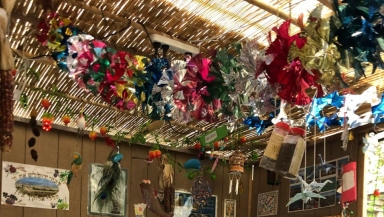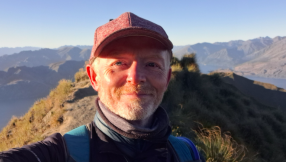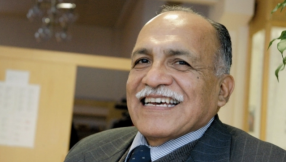
Jewish academic and Hebrew scholar Irene Lancaster reflects on some of Judaism's sacred traditions amidst current trials.
On October 14 Manchester made history. That was the date on which Manchester airport hosted the first ever direct flight to Israel on an Israeli airline.
On October 14 Arkia, a budget Israeli airline, flew a large number of pilgrims from Manchester and the north of England to Tel Aviv by night, so that they could enjoy the festival of Sukkot in the Holy Land.
Even the Manchester airport staff were excited and some said said they'd actually like to accompany us on this historic first trip. I was honoured to be the first passenger aboard.
The head teacher from Gateshead seated next to me kindly offered a potato bureka. It was truly delicious and after a snack and settling the babies, most people tried to get some sleep on this first night flight, which only took four and a half hours.
A young man studying at Herzlyia University offered to help me through the airport and onto the train to Jerusalem, but, to my great joy, we found my son in law waiting at arrivals with Mocha, their little dog.
The car journey to Jerusalem took only an hour and there in a temporary Jerusalem apartment, were my daughter and baby Ahava, now three and a half months old, who smiled as if she had known me all her life!
The courtyard of this block of flats was already studded with sukkahs, temporary abodes, for the upcoming festival of Sukkot, also known as Tabernacles, to remind us of the Children of Israel dwelling in tents during their trek through the desert to the Promised Land.
As usual I slept in the safe room, which also doubles as my son in law's office.
We were invited out to both evening and lunchtime meals in two different sukkahs, whose hosts from Australia and the US had ties with the UK. Baby Ahava enjoyed every moment and was welcomed with open arms by all and sundry.
At lunch I was seated next to a young French Oleh (new immigrant) originally from Algeria. There was also a lone soldier who had emigrated especially to join the IDF and help fight this existential war for the survival of the Jewish people. His Hebrew was amazing.
There were a number of young girls studying at seminaries situated near the border with Gaza who were being hosted by an Australian lady in our building. Some wanted to remain in Israel. The food was a combination of exotic Ashkenazi and Sephardi delights. Truly delicious.
The synagogue services were, as usual, held in the children's play area, with the climbing frame and slide much in evidence. The gabbai who arranges the services had prepared meticulously beforehand and everything went without a hitch.
Birds wandered in and out and children participated fully throughout, including baby Ahava of course, whose father managed to carry her and the Sefer Torah at the same time!
During the intermediary days known as Chol HaMoed, my son in law entertained the community on his guitar in a number of sukkahs which were open to all.
We also visited the more central Jerusalem neighbourhood of Nachlaot where my elder daughter lived 22 years ago, on first moving to Israel.
Things have changed and now Nachlaot appears to be a venue for aging hippies, where self-expression and musical Hallel (Psalms 113-118) are de rigueur. I was suddenly wafted back to the late 60s and life as a university student. What a contrast to the other Sukkot services. But here too sukkahs are open to all.
People had arrived from all over the country to be in Jerusalem for this most important of food festivals. They brought their own picnics with them and made good use of the hospitality of sukkah owners in this neighbourhood of central Jerusalem.
We ourselves managed to build our own sukkah in a tiny open space off the apartment and both baby Ahava and Mocha the dog loved being there.
Towards the end of the festival I was invited to a learning session taking place in the largest sukkah in the compound courtyard. A mathematical analysis of the Hebrew letters was flowing along nicely when suddenly one of the guests mentioned if anyone knew about the Nazir of Jerusalem and his son, Chief Rabbi Shear Yashuv Cohen, and their association with Hoshana Rabba, Simchat Bet Hashoeva (Water Drawing Libation Ceremony) and the joy of Simchat Torah.
Well, I couldn't remain silent could I? So I mentioned my involvement in their story, as the author of the English language version of the biography of Chief Rabbi Shear Yashuv Cohen of Haifa who, I said, had organized all these festivals as informal chaplain in the prisoner of war camp in Jordan, after the heroic fighters for the Old City of Jerusalem had surrendered to the Arabs in the 1948 War of Independence.
'My father was with him'.
'Who was that' I asked.
'Yehiel Wultz.'
'Yes, your father taught violin to the young Shear Yashuv and your father's violin accompanied him to the POW Camp.'
Well, you could have heard a pin drop and I was even offered another piece of cake!
Incidentally, later in the pool, I met a fellow swimmer who informed me that her family had lived next door to the family of Rabbi Shear Yashuv in central Jerusalem before he moved to Haifa as Chief Rabbi in 1975. His daughter Eliraz had taken her to primary school every day. Eliraz is a good friend who has addressed our dialogue group!
Two friends of this great rabbi who I had encountered in Haifa. Surely no mere coincidence!
In Israel the two final autumn festivals of Shemeni Atzeret and Simchat Torah are combined, which makes for a very long service. But here it was spectacular.
The Hakafot, dancing and singing with lulav, etrog and Sefer Torah, were prefaced by psalms 130 or 121, and a specific Israeli group was mentioned before the performance of each Hakafah in memory of last year's Simchat Torah massacre.
Those mentioned included the dead, the hostages, the soldiers in the IDF, the wounded, the displaced, the widows, orphans and bereaved, as well as the victims of antisemitism everywhere.
All done outside in the matching weather which included a unique combination of burning sun, biting wind and very cold air. Definitely the turn of the year from summer to autumn as the first book of Bereshit - Genesis - is read once again 'In the beginning'.
Later on that very first Shabbat of the new year of 5785 we celebrated a large kiddush in honour of a couple about to get married. The rabbi contrasted the light of the first Book of Genesis created solely by G-d for our benefit to the light of Exodus in which we humans work together with G-d to bring light to the world.
He held up this new couple as themselves shining examples of light to the world. In their own speeches they spoke about this unique community who had worked together throughout Covid and now during the War.
And all I can say is that this truly is a couple of light who even hosted the special kiddush for the birth of my granddaughter at which I was present on Shabbat July 13, together with my other daughter and family who came from elsewhere in Israel and we all danced together with baby Ahava!
On Sunday night my son in law drove me back to the airport. It took only 40 minutes. The flight was late and I arrived back in Manchester at 10.30 am. A very kind fellow passenger from Israel offered me a lift home. I was therefore able to make it to our monthly Shul Monday Club for 2.00 pm, through the carpet of orange leaves, in order to hear a talk relevant to the upcoming Book of Noah and the Jewish approach to vegetarianism.
I was also able to lend a new book by Rabbi Shlomo Brody to my rabbi, a gift from the author's mother, (also first encountered in the pool), which I hope to review at a later date. It is entitled 'Ethics of our Warriors' and is most apt for our present time.
The author spoke most movingly about Israel's approach to what is termed 'Assisted Dying' at a talk he gave in July which I attended. Another article for CT perhaps.
Let's finish with two sections of the Shear Yashuv Cohen story which I dedicate to the memory of his violin teacher, Dr Yehiel Wultz, whose son I met in a Jerusalem Sukkah, and to all Israeli musicians, including son in law Levi Dov, bringing love and joy to a grieving people at this existential epoch in our Jewish history.
'Love of song and niggun (religious melodies) was central to the Nazir's way of life. 'Niggun will always be the spiritual life and core of my soul.' He even wrote some niggunim himself. It was this love that led him to hire a special teacher, Dr Yechiel Wultz, who taught his two children to play the violin. Under the direction of the Nazir, Dr Wultz also taught them sacred niggunim, including a special melody by Rav Kook, as well as compositions by their own father, the Nazir.
Dr Wultz commented many years later: 'The young Shear Yashuv did not regard music simply as an art, but actually considered it to be something holy.For him music was an instrument for the worship of G-d.'
Later at the cobbled together Simchat Bet Shoeva which took place during the Sukkot week of 1948 in the Jordanian POW camp, this was the story of the survival of Dr Wultz' violin from Shear Yashuv's childhood.
'This day commemorates the Water Libation Ceremony which took place when the Temple was still standing. In our camp synagogue venerable elderly Jews began humming to themselves, while their feet started dancing.
Yehuel Wultz, my childhood violin teacher, took out the violin which he had brought with him from the Old City, tensed his bow and allowed his hands to do the rest. It occurred to us that at this very moment people would also be dancing in synagogues in Jerusalem.
However, whoever did not experience our own special POW Simchat Bet Shoeva has never really experienced a simcha in their lives! And whoever did not witness the Arab Debka performed by these elderly gentlemen from the Old City and by members of Kibbutz Ein Tzurim and Revadim, survivors of the massacre at Kfar Etzion, and the Old City combatants, has never experienced a true dance in all their born days.
A young man sang a typical Middle Eastern Arab niggun, and, quick as a flash, the Arab soldiers started to join in, celebrating together with us, stamping their feet, clapping their hands, and having a thoroughly good time.
In short, the Hora we danced around the Sukkah embraced hundreds of camp inmates. They were old. They were young. They were Kabbalists. They were aged Sephardim. They were aged Ashkenazim. They were young with black curly forelocks. They were young, in short sleeves and undershirts. And they all danced together as one. And all of them were friends. And all of them were joyful.
And what exactly was this joyful simcha? it was the Simchat Bet Shoeva. And where did it take place? In the midst of the desert. And when did it take place? When we were imprisoned in a OPOW camp, after the fall of the Old City.
And at the very heart of this simcha, in the midst of our rejoicing, we secretly hoped and yearned to return to Jerusalem so that in the future we could celebrate Sukkot there.'
[Taken from 'Rabbi Shear Yashuv Cohen', Urim Publications Jerusalem 2017, English language version and editor Dr Irene Lancaster, p 42 and pp 172-173]













